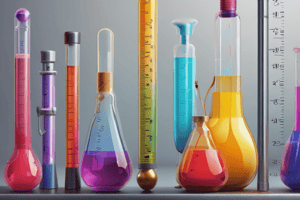Podcast
Questions and Answers
How many liters are equivalent to 1 cubic meter?
How many liters are equivalent to 1 cubic meter?
- 100 L
- 1000 L (correct)
- 500 L
- 1500 L
Which of the following describes significant figures?
Which of the following describes significant figures?
- Exact numbers have uncertainty.
- Nonzero digits and interior zeroes are significant. (correct)
- Leading zeroes are always significant.
- All digits in a measurement are considered uncertain.
What is one example of an exact number?
What is one example of an exact number?
- 12 inches in a foot (correct)
- Weight measured on a scale
- Temperature measured in Celsius
- Height measured in centimeters
Which of the following fields heavily relies on chemistry for environmental assessment?
Which of the following fields heavily relies on chemistry for environmental assessment?
What is the rule regarding trailing zeroes after a decimal point?
What is the rule regarding trailing zeroes after a decimal point?
What distinguishes pure substances from mixtures?
What distinguishes pure substances from mixtures?
Which countries have not officially adopted SI units as their standard system?
Which countries have not officially adopted SI units as their standard system?
What best indicates the reliability of a reported number in experimental results?
What best indicates the reliability of a reported number in experimental results?
Which process is characteristic of chemical changes?
Which process is characteristic of chemical changes?
What defines a scientific law?
What defines a scientific law?
Which operation does NOT violate the rules of significant figures?
Which operation does NOT violate the rules of significant figures?
Which of the following is true about leading zeroes?
Which of the following is true about leading zeroes?
Which of the following is a physical property?
Which of the following is a physical property?
What is the first step in the scientific method?
What is the first step in the scientific method?
In which area can the application of chemistry significantly impact agricultural practices?
In which area can the application of chemistry significantly impact agricultural practices?
Which of the following describes a change in the state of matter?
Which of the following describes a change in the state of matter?
What is the formula used to calculate density?
What is the formula used to calculate density?
What mass did the man find for the platinum ring?
What mass did the man find for the platinum ring?
What volume of water was displaced by the ring?
What volume of water was displaced by the ring?
Based on the given density of platinum, what would be the expected density of the ring?
Based on the given density of platinum, what would be the expected density of the ring?
How should irregularly shaped objects be measured for volume?
How should irregularly shaped objects be measured for volume?
If the ring's density is calculated, and is lower than 21.5 g/cm³, what can be concluded?
If the ring's density is calculated, and is lower than 21.5 g/cm³, what can be concluded?
Which common substance has a density closest to that of aluminum?
Which common substance has a density closest to that of aluminum?
What is the significance of the displacement method in measuring volume?
What is the significance of the displacement method in measuring volume?
What happens to the significant figures in the result when multiplying two measurements?
What happens to the significant figures in the result when multiplying two measurements?
When performing the operation $6.8 + 11.934$, how many decimal places should the final result have?
When performing the operation $6.8 + 11.934$, how many decimal places should the final result have?
In a scenario where a measurement of $1.23 ext{ g}$ is subtracted by $0.567 ext{ g}$, what will be the correct number of significant figures in the final answer?
In a scenario where a measurement of $1.23 ext{ g}$ is subtracted by $0.567 ext{ g}$, what will be the correct number of significant figures in the final answer?
When adding $37.657 - 2.1$, what will be the correct final answer rounded according to significant figures?
When adding $37.657 - 2.1$, what will be the correct final answer rounded according to significant figures?
What is the measure of accuracy in experiments?
What is the measure of accuracy in experiments?
Which type of error can be reduced or eliminated through proper calibration of instruments?
Which type of error can be reduced or eliminated through proper calibration of instruments?
What is the definition of precision in measurements?
What is the definition of precision in measurements?
If a measurement has 4 decimal places, how many decimal places should the result have when added to a measurement with 2 decimal places?
If a measurement has 4 decimal places, how many decimal places should the result have when added to a measurement with 2 decimal places?
What type of error is described as being precise but not accurate?
What type of error is described as being precise but not accurate?
Which formula calculates the mean of a set of values?
Which formula calculates the mean of a set of values?
What does a standard deviation measure in a set of values?
What does a standard deviation measure in a set of values?
What is the boiling point in Celsius according to Celsius' original scale?
What is the boiling point in Celsius according to Celsius' original scale?
At absolute zero, the temperature in Kelvin is what value?
At absolute zero, the temperature in Kelvin is what value?
Which equation correctly converts Celsius to Kelvin?
Which equation correctly converts Celsius to Kelvin?
If a temperature is given as 20 °C, what is its equivalent in Fahrenheit?
If a temperature is given as 20 °C, what is its equivalent in Fahrenheit?
What type of error results when measurements are random and lack consistency?
What type of error results when measurements are random and lack consistency?
Flashcards are hidden until you start studying
Study Notes
Importance of Studying Chemistry
- Chemistry is essential for various fields, such as water and soil testing, atmospheric science, and understanding climate change.
- It plays a crucial role in materials science, medicine (human and veterinary), solar energy conversion, agriculture, and pharmaceuticals.
- Chemistry intersects with engineering, geology, and biology in sectors like mining, manufacturing, and power plants.
Particles of Matter: Chapter Overview
- Understand the difference between pure substances and mixtures.
- Recognize physical properties versus chemical properties and physical processes versus chemical processes.
- Identify physical states of matter and recognize changes in state.
The Scientific Method
- Observation: Systematic recording of natural phenomena.
- Hypothesis: A tentative explanation for specific natural occurrences.
- Experiment: Testing a hypothesis to produce evidence.
- Theory: A well-substantiated explanation of natural phenomena.
- Law: A consistently observed natural phenomenon.
SI Base Units
- Base units are fundamental for various calculations.
- Common measurements include mass (grams), volume (liters), and length (meters).
- Density can be determined through mass and volume measurements.
Density Calculation Example
- Given a platinum ring's mass of 3.15 grams and water displacement of 0.233 cm³, calculate density to ascertain material type.
- Density of platinum is 21.5 g/cm³; compare with other substances like gold (19.3 g/cm³) and aluminum (2.70 g/cm³).
Dimensional Analysis
- Process of converting measurements from one unit to another.
- Use conversion factors, e.g., 1 km = 0.6214 miles.
SI vs. US Measurement Systems
- The US remains one of the few countries not using SI units as standard.
- Canada and the UK utilize a mixed measurement system primarily based on SI units.
Evaluating Experimental Results
- Reliability of measurements is conveyed using significant figures, which reflect the precision of recorded values.
Significant Figures
- All measurements have uncertainties based on the measuring instrument.
- Count significant figures by rules: non-zero digits are significant, interior zeroes between non-zero digits are significant, leading zeroes are not significant, and trailing zeroes have varying significance depending on the context.
Mathematical Operations with Significant Figures
- Multiplication/Division: The result has the same significant figures as the measurement with the fewest significant figures.
- Addition/Subtraction: The result has as many decimal places as the measurement with the least decimal places.
Types of Measurement Errors
- Systematic Error: Identifiable errors due to instrument calibration.
- Random Error: Variability due to the experimenter's limitations.
- Accuracy: Closeness to the true value; Precision: Reproducibility of measurements.
Temperature Measurement
- Temperature reflects the average kinetic energy, with Celsius (°C) used worldwide and Kelvin (K) as the absolute scale.
- Key conversions between Celsius, Fahrenheit, and Kelvin:
- °C = (°F - 32) × 5/9
- K = °C + 273.15
Example Temperature Conversion
- Extreme temperature recorded at -128.6 °F in Antarctica converted to °C and K.
Studying That Suits You
Use AI to generate personalized quizzes and flashcards to suit your learning preferences.




